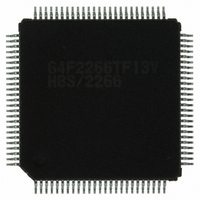DF2266TF13V Renesas Electronics America, DF2266TF13V Datasheet - Page 419

DF2266TF13V
Manufacturer Part Number
DF2266TF13V
Description
IC H8S/2266 MCU FLASH 100-TQFP
Manufacturer
Renesas Electronics America
Series
H8® H8S/2200r
Datasheet
1.DF2266TF20V.pdf
(712 pages)
Specifications of DF2266TF13V
Core Processor
H8S/2000
Core Size
16-Bit
Speed
13MHz
Connectivity
I²C, SCI, SmartCard
Peripherals
LCD, POR, PWM, WDT
Number Of I /o
67
Program Memory Size
128KB (128K x 8)
Program Memory Type
FLASH
Ram Size
8K x 8
Voltage - Supply (vcc/vdd)
3 V ~ 5.5 V
Data Converters
A/D 10x10b
Oscillator Type
Internal
Operating Temperature
-20°C ~ 75°C
Package / Case
100-TQFP, 100-VQFP
Lead Free Status / RoHS Status
Lead free / RoHS Compliant
Eeprom Size
-
- Current page: 419 of 712
- Download datasheet (5Mb)
13.7.5
Before transmitting and receiving data, initialize the SCI as described below. Initialization is also
necessary when switching from transmit mode to receive mode, or vice versa.
1. Clear the TE and RE bits in SCR to 0.
2. Clear the error flags ERS, PER, and ORER in SSR to 0.
3. Set the GM, BLK, O/E, BCP0, BCP1, CKS0, CKS1 bits in SMR. Set the PE bit to 1.
4. Set the SMIF, SDIR, and SINV bits in SCMR.
5. Set the value corresponding to the bit rate in BRR.
6. Set the CKE0 and CKE1 bits in SCR. Clear the TIE, RIE, TE, RE, MPIE, and TEIE bits to 0.
7. Wait at least one bit interval, then set the TIE, RIE, TE, and RE bits in SCR. Do not set the TE
To switch from receive mode to transmit mode, after checking that the SCI has finished reception,
initialize the SCI, and set RE to 0 and TE to 1. Whether SCI has finished reception or not can be
checked with the RDRF, PER, or ORER flags. To switch from transmit mode to receive mode,
after checking that the SCI has finished transmission, initialize the SCI, and set TE to 0 and RE to
1. Whether SCI has finished transmission or not can be checked with the TEND flag.
13.7.6
As data transmission in Smart Card interface mode involves error signal sampling and
retransmission processing, the operations are different from those in normal serial communication
interface mode (except for block transfer mode). Figure 13.29 illustrates the retransfer operation
when the SCI is in transmit mode.
1. If an error signal is sent back from the receiving end after transmission of one frame is
2. The TEND bit in SSR is not set for a frame in which an error signal indicating an abnormality
3. If an error signal is not sent back from the receiving end, the ERS bit in SSR is not set.
When the SMIF bit is set to 1, the TxD and RxD pins are both switched from ports to SCI pins,
and are placed in the high-impedance state.
If the CKE0 bit is set to 1, the clock is output from the SCK pin.
bit and RE bit at the same time, except for self-diagnosis.
complete, the ERS bit in SSR is set to 1. If the RIE bit in SCR is enabled at this time, an ERI
interrupt request is generated. The ERS bit in SSR should be cleared to 0 by the time the next
parity bit is sampled.
is received. Data is retransferred from TDR to TSR, and retransmitted automatically.
Transmission of one frame, including a retransfer, is judged to have been completed, and the
Initialization
Serial Data Transmission (Except for Block Transfer Mode)
Section 13 Serial Communication Interface (SCI)
Rev. 5.00 Sep. 01, 2009 Page 367 of 656
REJ09B0071-0500
Related parts for DF2266TF13V
Image
Part Number
Description
Manufacturer
Datasheet
Request
R

Part Number:
Description:
CONN SOCKET 2POS 7.92MM WHITE
Manufacturer:
Hirose Electric Co Ltd
Datasheet:

Part Number:
Description:
CONN SOCKET 4POS 7.92MM WHITE
Manufacturer:
Hirose Electric Co Ltd
Datasheet:

Part Number:
Description:
CONN SOCKET 5POS 7.92MM WHITE
Manufacturer:
Hirose Electric Co Ltd
Datasheet:

Part Number:
Description:
CONN SOCKET 3POS 7.92MM WHITE
Manufacturer:
Hirose Electric Co Ltd
Datasheet:

Part Number:
Description:
CONN SOCKET 5POS 7.92MM WHITE
Manufacturer:
Hirose Electric Co Ltd
Datasheet:

Part Number:
Description:
CONN SOCKET 2POS 7.92MM WHITE
Manufacturer:
Hirose Electric Co Ltd
Datasheet:

Part Number:
Description:
CONN SOCKET 3POS 7.92MM WHITE
Manufacturer:
Hirose Electric Co Ltd
Datasheet:

Part Number:
Description:
CONN SOCKET 4POS 7.92MM WHITE
Manufacturer:
Hirose Electric Co Ltd
Datasheet:

Part Number:
Description:
CONN HEADER 2POS 7.92MM R/A TIN
Manufacturer:
Hirose Electric Co Ltd
Datasheet:

Part Number:
Description:
CONN HEADER 4POS 7.92MM R/A TIN
Manufacturer:
Hirose Electric Co Ltd
Datasheet:

Part Number:
Description:
KIT STARTER FOR M16C/29
Manufacturer:
Renesas Electronics America
Datasheet:

Part Number:
Description:
KIT STARTER FOR R8C/2D
Manufacturer:
Renesas Electronics America
Datasheet:

Part Number:
Description:
R0K33062P STARTER KIT
Manufacturer:
Renesas Electronics America
Datasheet:

Part Number:
Description:
KIT STARTER FOR R8C/23 E8A
Manufacturer:
Renesas Electronics America
Datasheet:

Part Number:
Description:
KIT STARTER FOR R8C/25
Manufacturer:
Renesas Electronics America
Datasheet:










